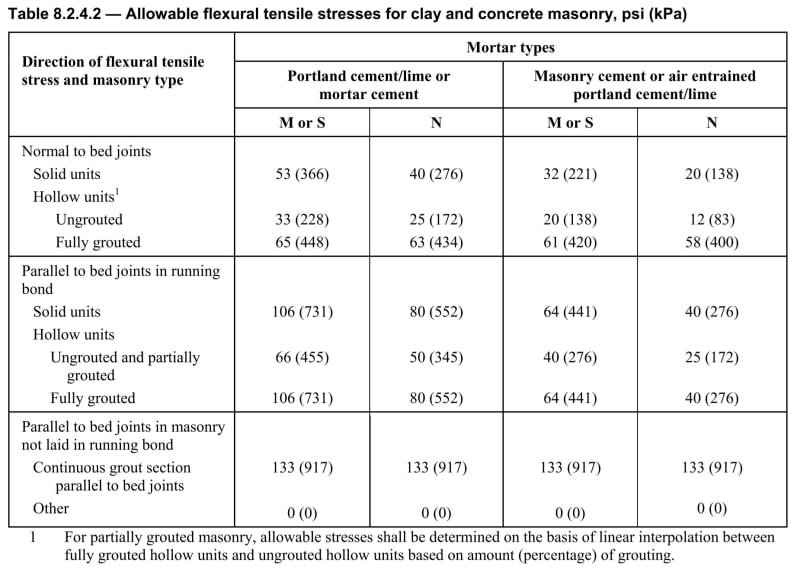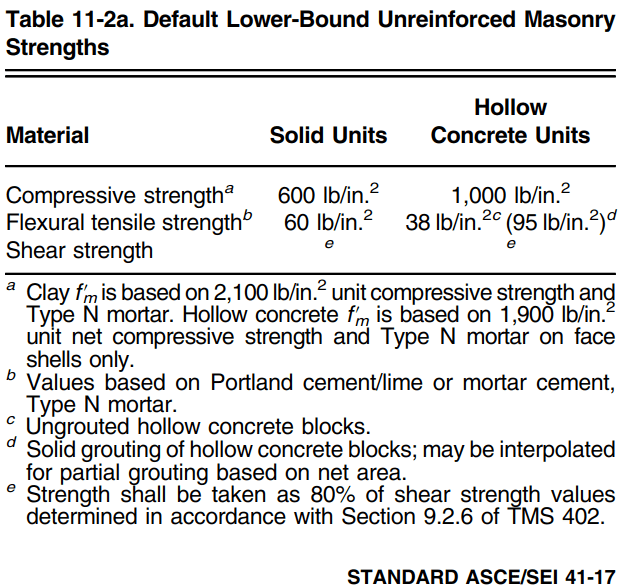I typically analyze existing concrete/steel structures. However, on occasion, I'm tasked with analyzing an existing brick/masonry structure. I'm hoping someone can provide some feedback on this particular table.

More often than not, I am using the first section, normal to bed joints. However, I am in the process of building an elaborate spreadsheet as a way for me to better understand masonry design to see if I can possibly gain more capacity since I can tell a lot of these really old brick walls have been around for 100 years and I can tell they didn't consider current code in their design, so they shouldn't be standing (on paper).
I'm trying to figure out what the other two categories even mean. It seems they are for walls spanning horizontally, but I am not sure. I don't have any idea when "continuous grout section parallel to bed joints" would ever apply. Maybe some sort of unreinforced lintel or grouted clay tile (which obviously isn't used anymore)? I don't know how else you would get grout parallel to the bed joint.
Also, does anyone have a good reference for engineering historic brick walls? For engineering properties, it seems I should be able to assume that it is comparable to a solid CMU wall of the same nominal dimension. However, this gets a little tricky with multi-wythe brick walls. If anything it seems the triple-wythe brick wall should be a little bit larger than a solid 12" CMU wall.
Lastly, I'm not sure if historic brick has holes in it or not. I'm guessing this will change the Anet a little bit but it will also change the adhesive anchor design. It becomes difficult with Hilti when they say the wall needs to be 13" thick but a triple-wythe wall should be less than this. Thanks for any insight you can give me.

More often than not, I am using the first section, normal to bed joints. However, I am in the process of building an elaborate spreadsheet as a way for me to better understand masonry design to see if I can possibly gain more capacity since I can tell a lot of these really old brick walls have been around for 100 years and I can tell they didn't consider current code in their design, so they shouldn't be standing (on paper).
I'm trying to figure out what the other two categories even mean. It seems they are for walls spanning horizontally, but I am not sure. I don't have any idea when "continuous grout section parallel to bed joints" would ever apply. Maybe some sort of unreinforced lintel or grouted clay tile (which obviously isn't used anymore)? I don't know how else you would get grout parallel to the bed joint.
Also, does anyone have a good reference for engineering historic brick walls? For engineering properties, it seems I should be able to assume that it is comparable to a solid CMU wall of the same nominal dimension. However, this gets a little tricky with multi-wythe brick walls. If anything it seems the triple-wythe brick wall should be a little bit larger than a solid 12" CMU wall.
Lastly, I'm not sure if historic brick has holes in it or not. I'm guessing this will change the Anet a little bit but it will also change the adhesive anchor design. It becomes difficult with Hilti when they say the wall needs to be 13" thick but a triple-wythe wall should be less than this. Thanks for any insight you can give me.

